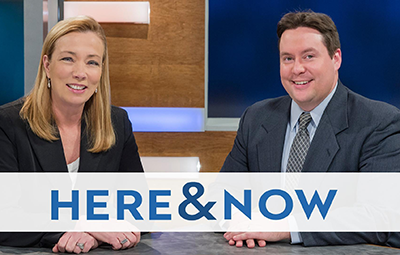Frederica Freyberg:
Property loss due to flooding like what happened in Milwaukee is likely not covered by the standard homeowner’s insurance policy. It would be covered up to a point under flood insurance. But according to the state Insurance Commissioners Office, Wisconsin has one of the lowest number of flood insurance policies in the nation, at under 11,000 of more than 2.7 million households. Our next guest researches flood insurance costs and benefits as assistant professor in the Risk and Insurance Department at the Wisconsin School of Business. Philip Mulder joins us now. And thanks for being here.
Philip Mulder:
Thank you, Frederica. Happy to be here.
Frederica Freyberg:
So what’s the explanation for why so few people hold flood insurance? Do they not know that they need it?
Philip Mulder:
I think that it’s a variety of cases. You know, on the one hand, especially in a state like Wisconsin, where we’re not used to thinking of floods as a regular risk, a lot of people don’t do the due diligence that you would need to discover that your homeowner’s insurance policy doesn’t cover that peril, right? You may be told that as you buy the policy, but maybe you forget over time, or you don’t notice as you’re kind of finalizing the details. In other cases, maybe people do know that flood isn’t covered, but it is an extra cost. It can be on the low end, you know, $300, $400 a year. On the high end, if you are in a high-risk area, maybe even thousands of dollars a year. For a lot of households that’s outside of their immediate budget, especially if flooding isn’t top of mind as a, as a potential risk.
Frederica Freyberg:
Certainly top of mind right now, right after what happened in Milwaukee. But I put a Milwaukee address that did experience flood damage into the flood risk calculator, and it came out as low risk. Are flood maps accurate and have they changed recently? Do they change a lot?
Philip Mulder:
The information that we have about flood risk can often be, I think, confusing to the typical household. It’s sort of important to break down what might be out there. On the one hand, you have sort of what we’ve always called flood maps, which are made by FEMA, and those can often be out of date. These are updated over time by the U.S. Army Corps of Engineers through studies. But that process can — is supposed to be done every five years, but often flood maps can be more than a decade out of date. Even when they are updated, they don’t always do a rigorous study. So, so yes, that information is often out of date. Even if you’re not in an official floodplain, your home may have substantial risk. The National Flood Insurance Program is using newer information now to price policies based on risk rating 2.0, but that can be very difficult for homeowners to learn about. So sometimes you’ll see information on the flood map that tells you you’re low risk. And another set of information may be telling you that you’re high risk.
Frederica Freyberg:
And so what should the homeowner do?
Philip Mulder:
Well, you know, it’s important to sort of take a holistic view of everything that you can do to learn about your risk. There’s also third-party tools out there, like First Street Foundation. I understand that the end of the day, this probably seems like throwing even more information at the home owner. I think looking into what the NFIP is charging you, this is the National Flood Insurance Program. You know, that premium is based off of their best estimate of your risk. If you’re being charged a high premium, it’s probably because you have high risk.
Frederica Freyberg:
And it seems to me that some people might explain away risk in Wisconsin by saying what happened in Milwaukee was a 1000-year flood. It’s not going to happen again.
Philip Mulder:
Well, you know, I mean, a 1 in 1000 chance of having your home ruined is a substantial risk, right? That’s what flood insurance and insurance in general is for, is to take something that yes, it’s unlikely, but if it were to happen, could be catastrophic. And to, and to, you know, get insure against that. The other thing too is, you know, when we talk about things like 1000-year or a 100-year flood, that’s a very tricky concept to wrap our heads around. It does not mean that this will only happen once every thousand years. There’s 1000-year floods every year somewhere in the country, right? And in addition, what is a 1000-year flood? That’s something that we can only estimate and that we think is changing with changing weather patterns.
Frederica Freyberg:
So if you buy a flood insurance policy, maybe you’re not even in a high-risk area, but maybe you just want to be covered. Does that then cover for replacement, or are they all different?
Philip Mulder:
You are probably going to be able to find some different types of coverage on the market. So, you know, I’ve thrown out the term NFIP, the National Flood Insurance Program, that is a federally run insurer, and they are the primary provider of flood insurance in the United States and including Wisconsin. They will sell you up to $250,000 of coverage. A lot of homes that will not cover the full replacement cost, but for some of the smaller floods, maybe primarily affect the lower levels of a home, which, which are more typical in Wisconsin, you might be able to get enough coverage. Now, there’s also private providers of flood insurance, and there you might be able to find more coverage options and things that can cover more expensive homes. It’s always important to talk things through with an agent or a broker, understand differences between actual cash value, replacement cost value policies. You know, these, these can definitely be tricky concepts.
Frederica Freyberg:
So given torrential rain events that are on the increase, should we all just assume that we need flood insurance?
Philip Mulder:
You know, it’s — I think it’s a decision that every household has to make for itself. What I hope is that people can go in with full information. I think that often people assume that they have low risk because they’re not in a floodplain. That’s not always going to be true. People will say things like, “Oh, I can’t get flood insurance. I’m not in a floodplain.” That’s not true. The National Flood Insurance Program will sell flood insurance in almost every community as a participating NFIP community, that means you can buy flood insurance inside or outside of the floodplain. So people should understand their options. Now there’s other steps you can take: sump pumps in your basement, elevating homes that are near waterways, keeping a buffer of savings. If you only face small, say, basement damages, you know, these are other tools that homeowners can use to handle flood risk. But flood insurance is definitely one of those tools, and households should take a look at their budgets and see if that makes sense.
Frederica Freyberg:
If you put a sump pump or other measures like that in your basement, does that reduce the cost if you buy flood insurance?
Philip Mulder:
Not in every case. And in addition, you know, some things are excluded through flood insurance policy. So basements in many cases, you might be on your own altogether, certainly for say, covering the contents down there. You know, flood insurance is really for dealing with the worst-case scenarios. I know that, you know, a $10,000 or $20,000 loss can be financially catastrophic to families, but ultimately, what flood insurance is for is even bigger losses, potentially the kind of flooding that could ruin your entire home.
Frederica Freyberg:
Wow. Well, Philip Mulder, thank you. Thank you so much for the information.
Philip Mulder:
Thank you. It was my pleasure.
Search Episodes

Donate to sign up. Activate and sign in to Passport. It's that easy to help PBS Wisconsin serve your community through media that educates, inspires, and entertains.
Make your membership gift today
Only for new users: Activate Passport using your code or email address
Already a member?
Look up my account
Need some help? Go to FAQ or visit PBS Passport Help
Need help accessing PBS Wisconsin anywhere?

Online Access | Platform & Device Access | Cable or Satellite Access | Over-The-Air Access
Visit Access Guide
Need help accessing PBS Wisconsin anywhere?

Visit Our
Live TV Access Guide
Online AccessPlatform & Device Access
Cable or Satellite Access
Over-The-Air Access
Visit Access Guide
 Passport
Passport






Follow Us